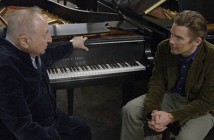Ken Kwapis is a relative newcomer to the Heartland family. Renowned in the industry for directing some of the most groundbreaking and intelligent shows on television, beginning with The Larry Sanders Show and including ER, Malcolm in the Middle, Freaks and Geeks, The Bernie Mac Show and The Office, Kwapis shared a 2000 Emmy Award nomination for his producing work on Malcolm in the Middle. He has also directed seven features, including He Said, She Said, and the Truly Moving Picture Award winner The Sisterhood of the Traveling Pants. Here he candidly shares his insights to the films to which he personally finds Most Truly Moving.
American Graffiti – “This film had a really profound affect on me,” Kwapis said. “When I saw it, I was in high school.”
Kwapis remembered “being struck by the fact” that this film was the interwoven stories of four boys and, what’s more, he could identify with each of them. “I saw myself in all of them,” he said. “And when I read the first draft of Sisterhood, I was struck by the same thing.” He realized that The Sisterhood of the Traveling Pants might help young women of today to have the same experience he had as a boy watching American Graffiti.
“[American Graffiti] is so deceptively simple – it seems to be just one night of antics,” he said. “But, for two of the main characters, over the course of that one night their lives are completely changed.”
He went on to talk about Richard Dreyfuss’ character, Curt, and the scene where he meets the “shlumpy” radio station DJ and discovers that this man, who has “God-like status among the high school kids,” is really the famed “Wolfman Jack.”
“Wolfman Jack” goes on to help Curt realize that he needs to get out of the small town at make something of his life, a piece of advice Kwapis himself has never forgotten.
“At the end, when he does go, and you see the plane flying off into the sky – I get choked up – you see the epilogues of the four boys,” Kwapis said. “You realize that [Curt’s epilogue as he becomes a Canadian writer] is the most profound…and one of the things he’s written is the story you’ve just watched.”
“I tried to keep all these things in mind when filming Sisterhood – that had a gigantic effect on me,” he said.
How Green Was My Valley – “It’s like a miracle of a film,” he said.
“It’s such a film about what defines a community. One of the brilliant things about it is that it has no plot. It’s episodic… but you never get a sense of it meandering – it’s driving.”
“The most powerful part is the sequence toward the end when [Roddy McDowell’s character, Huw’s] father gets trapped in the mine,” Kwapis said. “Everyone puts aside their problems for this one problem.” But what happened next, according to Kwapis, is what truly made the film moving. When it comes time for volunteers to go down into the mine, it is the comical blind character, Dai, who is first to step up in the rescue effort for Huw’s father, saying “he is the blood of my heart.”
At this point in the interview, Kwapis again mentioned The Sisterhood of the Traveling Pants and the parallels he tried to draw between his direction and films like How Green Was My Valley. He said many reviewers have seemed almost apologetic in their reviews about getting emotionally involved in Sisterhood and how perhaps they have a difficult time discerning between honesty and sentiment. Kwapis said he believes that Sisterhood demonstrates honesty in what could have been a sappy story, and that the actors themselves proved this as he left them to “do their own thing.”
Kwapis said How Green Was My Valley was similarly straightforward in showing the stoic quality of the town – “I don’t think there’s a dishonest moment in it,” he said.
All five of the main characters in The Sisterhood of the Traveling Pants gave these sorts of candid performances, according to Kwapis, but he told a specific story of Jenna Boyd, the actor who played Bailey. He explained how Boyd prepared for her role as a cancer patient by going to a pediatric oncology unit in a hospital and talking to the kids there, which in turn widened her scope to see what her character would really worry about. From her research, the 11 year–old girl was able to show that Bailey was not so worried about death, but rather about whether or not her friends would still want to hang out with her.
The Shop Around the Corner – Kwapis called this a “remarkable film,” which was remade into a musical theater project and later, the Tom Hanks/Meg Ryan project, You’ve Got Mail.
Part of the beauty in this film, Kwapis explained, is how the director, Ernst Lubitsch, “knows that the comedy is only as good as the drama is,” bringing to light the subplot of shop owner Hugo (Frank Morgan). By using the “down” side of drama in this film, Lubig was able to make the romance of Alfred (Jimmy Stewart) and Klara (Margaret Sullavan) more real.
The scene Kwapis noted in particular was late in the film, after the shop is closed and Hugo goes into his office in the back of the shop. The camera remains outside the office door and the audience can see him bring out a gun. But, what happens next, as Kwapis explained, is what makes the scene so powerful. “The camera makes a little arching move to give him his privacy,” Kwapis said. “You hear the gun go off and the lamp shatters, so you know he missed. He tried, but he missed.”
Kwapis said this scene shows how effective it was for Lubitsch to imply the action rather than show it, demonstrating respect for the character and subtly telling the audience to give Hugo his privacy.
Kwapis said he tried to use similar “eavesdropping” kinds of scenes in Sisterhood of the Traveling Pants, such as Lena’s “first kiss” scene or the scene where Tibby and Bailey are stargazing. He said filming scenes such as these is very important, giving the audience “the privilege to feel like a fly on the wall.”



